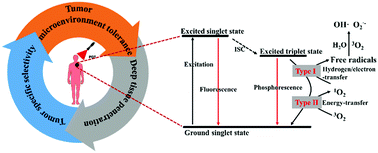Recent progress in photosensitizers for overcoming the challenges of photodynamic therapy: from molecular design to application
Abstract
Photodynamic therapy (PDT), a therapeutic mode involving light triggering, has been recognized as an attractive oncotherapy treatment. However, nonnegligible challenges remain for its further clinical use, including finite tumor suppression, poor tumor targeting, and limited therapeutic depth. The photosensitizer (PS), being the most important element of PDT, plays a decisive role in PDT treatment. This review summarizes recent progress made in the development of PSs for overcoming the above challenges. This progress has included PSs developed to display enhanced tolerance of the tumor microenvironment, improved tumor-specific selectivity, and feasibility of use in deep tissue. Based on their molecular photophysical properties and design directions, the PSs are classified by parent structures, which are discussed in detail from the molecular design to application. Finally, a brief summary of current strategies for designing PSs and future perspectives are also presented. We expect the information provided in this review to spur the further design of PSs and the clinical development of PDT-mediated cancer treatments.



 Please wait while we load your content...
Please wait while we load your content...